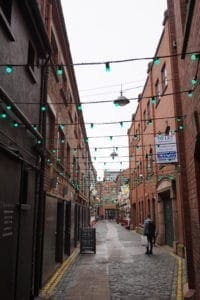Kabuki Theatres of Japan: Tradition, Drama, and Spectacle
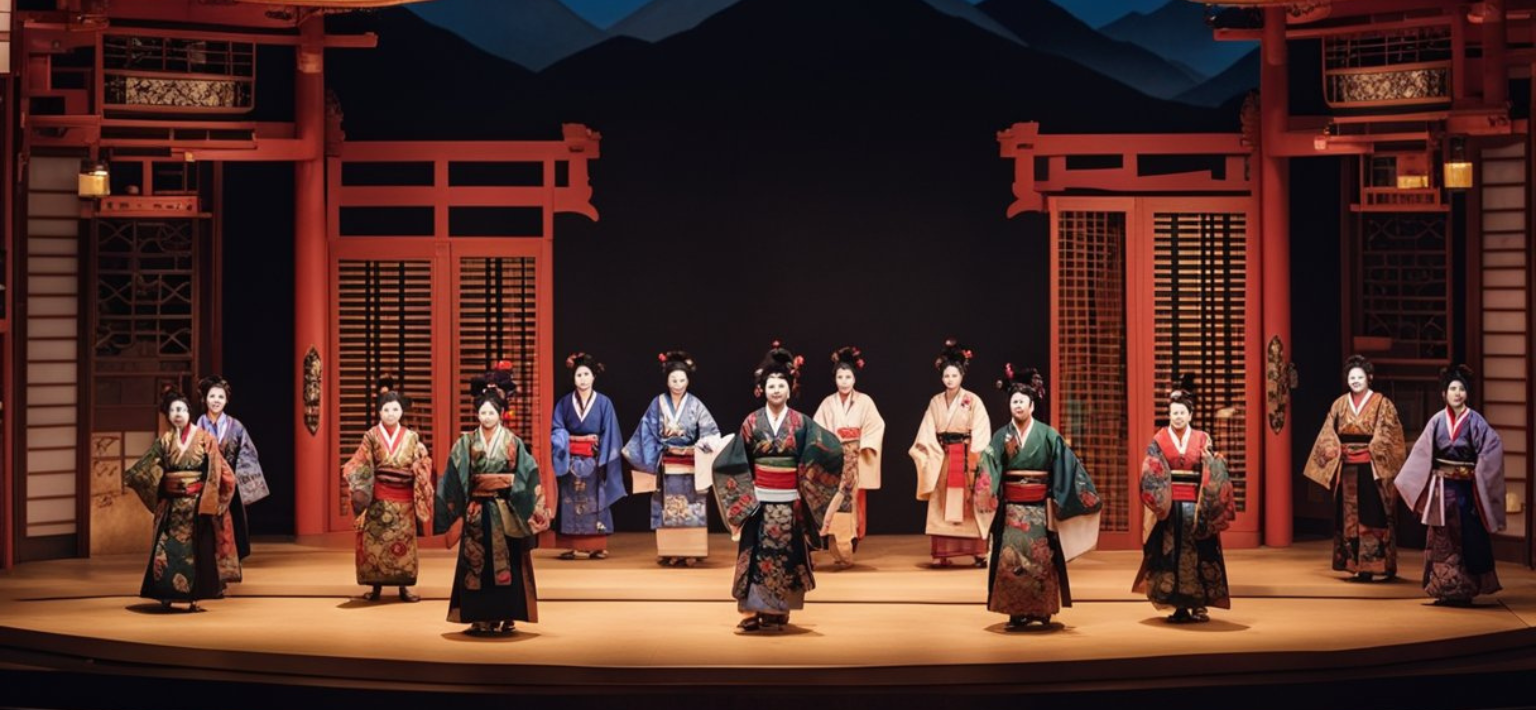
Updated On: April 22, 2024 by Raghda Elsabbagh
The Kabuki Theatres of Japan are a monumental testament to the nation’s dedication to preserving and promoting its traditional performing arts. Originating in the 17th century, kabuki has become one of Japan’s most recognised theatrical forms, as it masterfully interweaves drama, music, and dance. Its distinct character is marked by elaborate costumes and makeup, detailed choreography, and an architectural style that speaks to its historical significance. These theatres offer a feast for the senses, dazzling audiences with vivid visual storytelling that bridges the past and present.
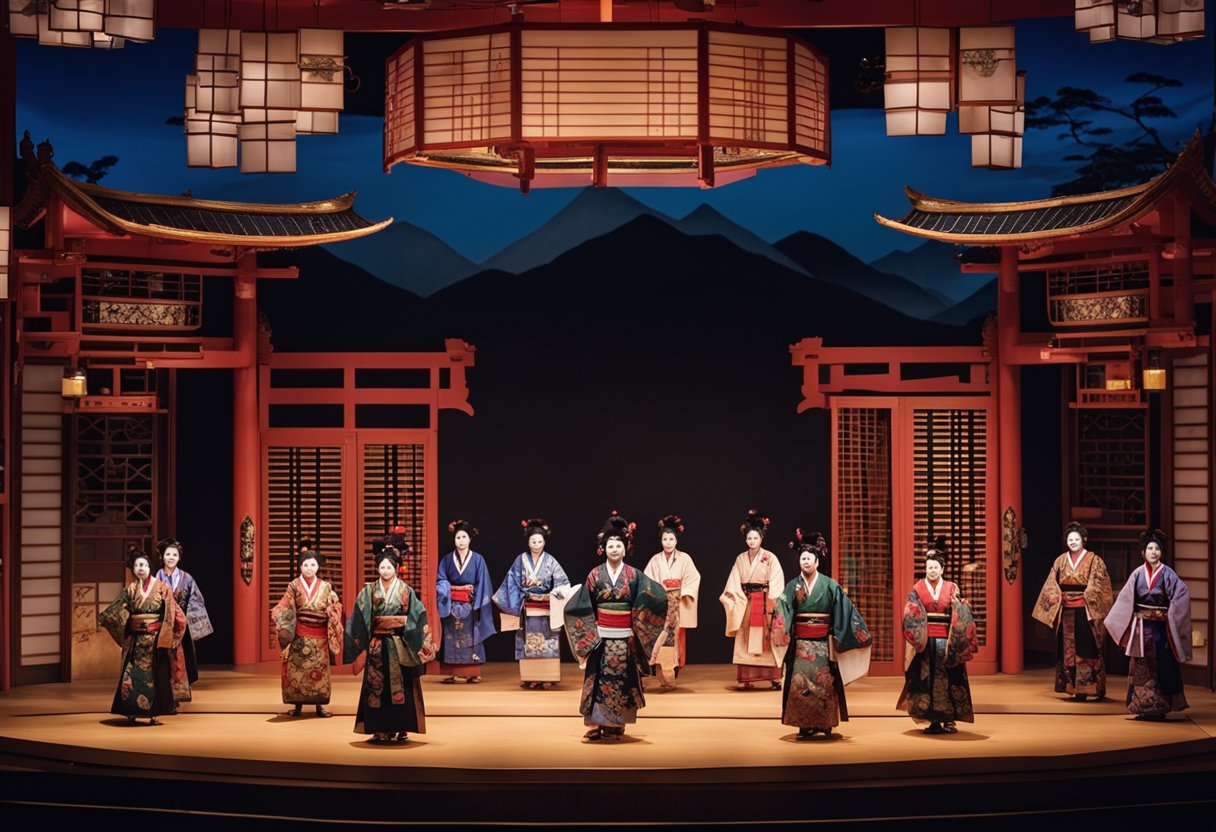
The essence of kabuki lies in its ability to evolve while maintaining the core principles of its tradition. Not only do these performances showcase the resilient spirit of Japanese culture, but they also capture the hearts of global audiences, contributing significantly to world theatre. Kabuki theatres possess a unique charm that transcends cultural barriers, embodying a fusion of spectacular artistry and profound narrative depth. They serve as an enduring source of cultural pride and an immersive gateway to the rich tapestry of Japan’s heritage.
Table of Contents
The Origins and Evolution of Kabuki Theatre

Kabuki began in the early 17th century when Izumo no Okuni, a former shrine maiden, started performing unique and somewhat provocative dance dramas along the Kamo River in Kyoto. Her performances, characterised by their flamboyant style and the female performers’ suggestive portrayal of both men and women, captivated the common people and attracted attention from the Imperial Court.
- 1603: Okuni’s performances mark the birth of Kabuki.
- 1629: Due to concerns about prostitution, the government banned women from performing, leading to young male actors taking their roles.
By the Edo period (1603–1868), Kabuki had matured into a sophisticated art form, encapsulating drama, dance, elaborate makeup, and costuming. Unlike the aristocratic Noh theatre, which catered to the elite, Kabuki was the theatre of the common people. It thrived amongst the townsfolk who sought escapism in the vibrant and sometimes salacious storylines.
- Stylisation and Speech: Dialogues became highly stylised with exaggerated actions to suit the tastes of commoners.
- Hanamichi: An iconic feature, the hanamichi (a walkway extending into the audience), was introduced, adding a new dimension to Kabuki’s staging.
Despite facing several government crackdowns, Kabuki persisted and evolved throughout the centuries, incorporating elements from other popular forms of the era and adapting to the times. Today, it continues to be a treasured cultural spectacle, paying homage to Japan’s rich historical tapestry of storytelling and performance art.
Architectural Grandeur of Kabuki Theatres of Japan
Stepping into a Kabuki theatre is like entering a world of cultural magnificence and architectural wonder. These spaces are designed to not only host the dramatic art of Kabuki but also to reflect its grandiosity and traditional essence.
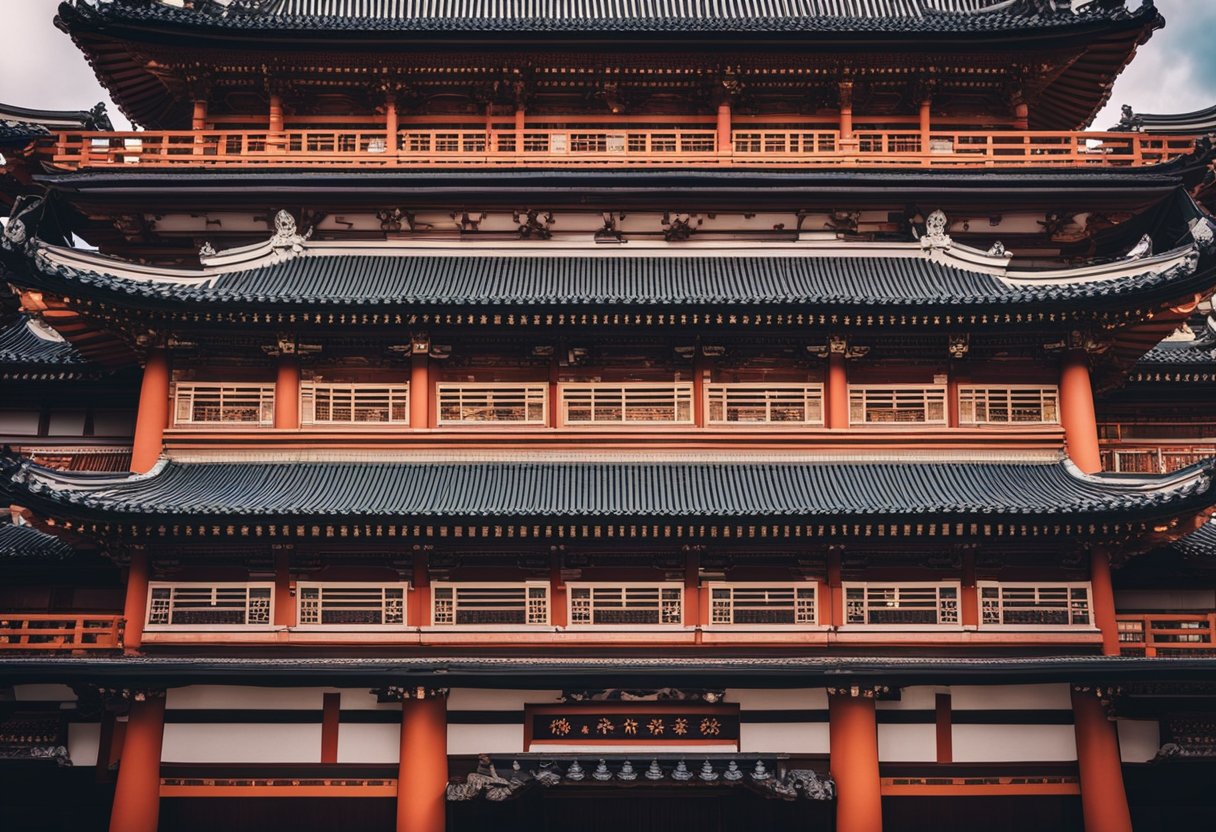
Nakamura-Za and Ichimura-Za
Nakamura-Za, a historic gem in the heart of the pleasure quarter, epitomised the opulence of Kabuki architecture during the Edo period. Nestled within Asakusa, it was a place where bold sets and elaborate props came to life. A striking feature of Nakamura-Za was the mawari-butai, a revolving stage that ingeniously transformed the scene before the audience’s eyes.
Similarly, Ichimura-Za in Tokyo stood as another beacon of cultural entertainment. It showcased the traditional performing arts, including Kabuki and the more reserved Noh theatre, and delighted audiences with its architectural ingenuity. The stage mechanics and trap doors, known as seri, were exceptional, creating a seamless flow of scenes that captivated and visibly enthralled theatregoers.
The Iconic Kabuki-Za
Moving to contemporary times, the famed Kabuki-Za in Ginza, Tokyo, continues the legacy of its predecessors with modern aplomb. It houses a grand edifice that marries traditional styles with present-day needs. Kabuki-Za’s stage is remarkably equipped to accommodate multifaceted performances, employing both historical stagecraft and the latest technology.
Minamiza in Kyoto, one of the oldest Kabuki theatres, also carries the architectural grandeur forward. It honours the essence of Japanese aesthetics while equipping itself as a full-fledged modern theatre capable of supporting complex and visually rich Kabuki performances.
The Distinctive Elements of Kabuki Performance
Kabuki theatre is an extravagant form of entertainment with unique features that distinguish it from other performing arts. Below, we’ll explore the components that make a kabuki performance truly stand out.
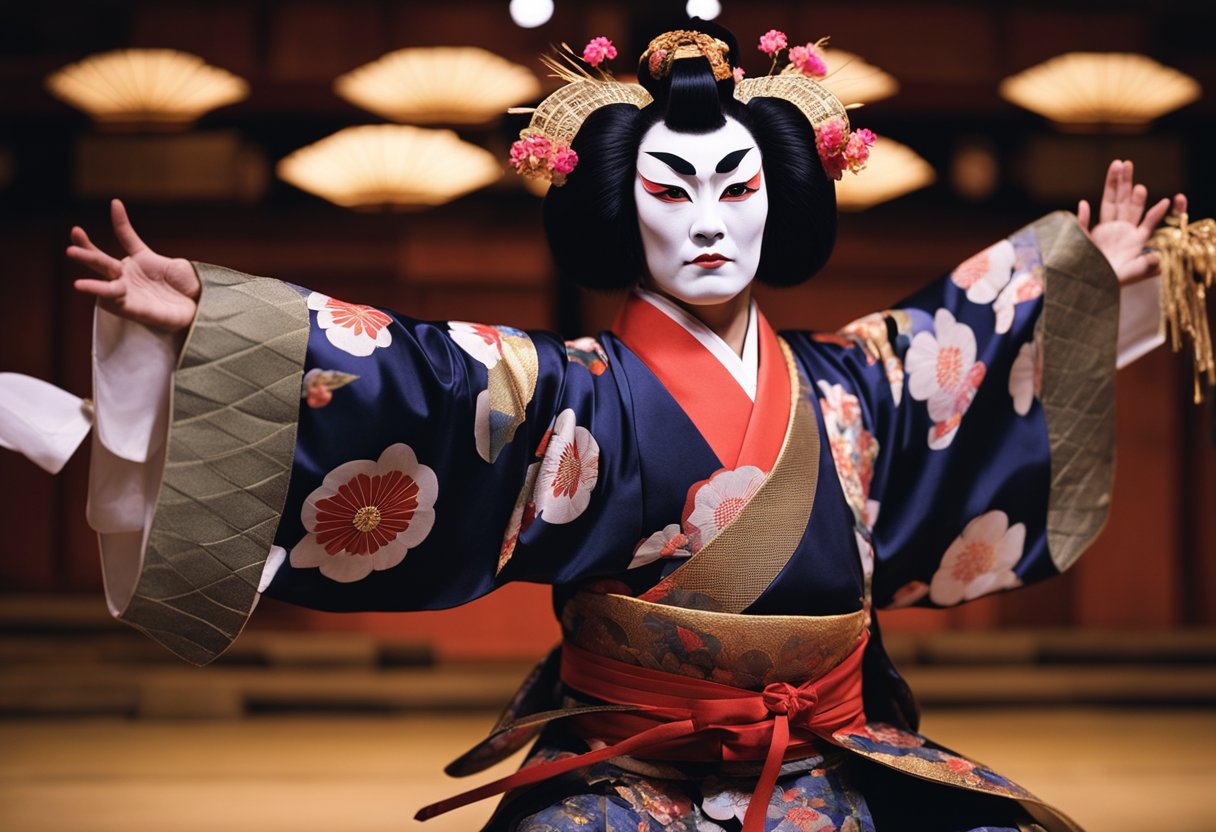
Kabuki Stagecraft
The stage in Kabuki theatre is renowned for its hanamichi, an extended walkway that stretches into the audience, allowing actors to move closer to the viewers, thus bridging the gap between them. This feature intensifies the drama and brings a three-dimensional action to the performances. The use of trapdoors and revolving stages adds to the dynamic presentation, often used to reveal characters or to swiftly change scenery, which can be seen through various historical events portrayed on stage.
Roles and Actor Specialisation
In kabuki, all roles are played by male actors, including those of women, known as onnagata. Specialisation is crucial; actors often spend years mastering male (tachiyaku) or female roles. The art of kabuki actors is not only characterised by their dramatic dialogue delivery but also by their ability to sing and dance in sync with the storyline. The mie, a significant pose struck by actors at climactic moments, is a distinctive kabuki convention amplified by the actor’s skill.
Musical Accompaniments
Music and sound effects play an indispensable role in kabuki performances, enhancing both the story’s atmosphere and the actors’ actions. Traditional instruments like the shamisen, flutes, and wooden clappers create a melodious backdrop while singers narrate the unfolding drama. The rhythmical interplay between music and dance often reflects the underlying emotions of a scene, attesting to kabuki’s deep entwinement with musical artistry.
The Visual Spectacle: Costumes, Makeup, and Props
In Kabuki theatre, visuals play a crucial role in storytelling. From vivid costumes to transformative makeup and elaborate props, each element is meticulously crafted to captivate the audience.
Costumes
Costuming is complex, as every kimono and garment differentiates roles and characters. Rich fabrics, bold patterns, and vibrant colours reflect rank, virtue, and personality. Samurai warriors don heavy armour and intricate wigs, while nobles and deities are adorned in layers of silk. Contrastingly, ghosts and villains are signified by darker, more imposing apparel.
Makeup
Kabuki makeup (keshō) is an art that transforms actors into iconic figures of Japanese folklore and history. Through a rigorous process using white rice powder, kumadori—the striking red, blue, and black lines—highlights expressions, with each colour symbolising traits such as anger, melancholy, or serenity.
Props
Props and set pieces range from hand-painted folding screens to wooden swords, all integral to the narrative. The careful selection of these objects supports the theatrical illusion.
Together, these visual components construct a feast for the eyes that’s both a guide to the story and a testament to the aesthetic precision of Kabuki theatre.
The Audience Experience in Kabuki
Venturing into Kabuki theatre, spectators are transported to a realm where tradition meets spectacle. Our journey reveals an entertainment experience that’s both immersive and interactive, centred around elaborate performances that have entertained audiences for centuries in Japan.
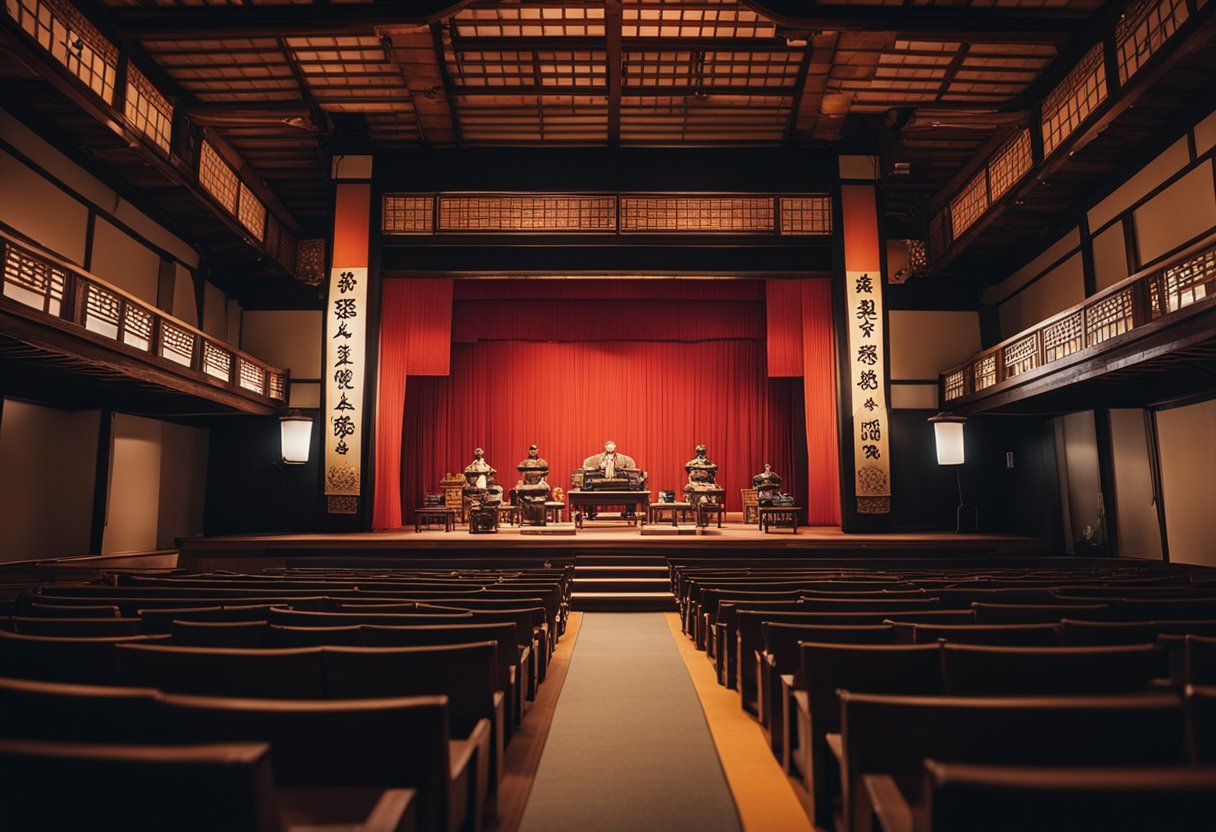
Interactivity and Engagement
Interaction with Performers: As a hallmark of Kabuki theatre, audience participation is encouraged. It’s not uncommon for attendees to call out actors’ names at pivotal moments, a practice known as kakegoe. This rapport between the performers and the audience adds a unique, energetic dimension to the spectacle.
Use of Props and Scenery: Spectators are often awestruck by the exquisite use of props, scenery, and mechanical devices, such as the mawari-butai (revolving stage) and seri (trapdoors), which effortlessly transport them through different scenes and narratives.
The Public and Critique
Critical Acclaim: Kabuki has garnered a faithful following over time, with spectators playing a crucial role in critiquing the performances. Prestigious theatres in Tokyo have become barometers for the art’s evolution, enabling audience members to witness and influence the transformation of Kabuki over the years.
Cultural Commentary: By attending a Kabuki play, the audience engages not just with the entertainment on stage but with a rich cultural dialogue. These performances often reflect societal issues, historical events, and moral tales, offering spectators a platform for introspection and critique.
Kabuki Dance: A Fusion of Drama and Choreography
Kabuki dance is an intrinsic component of Japanese theatrical performances, where drama and choreography meld into an impressive display of cultural artistry. Characterised by stylised action and dynamic movements, these dances tell stories that resonate with audiences beyond the language barrier.
The stage comes to life with an eclectic mix of music and rhythmic footwork, each element carefully crafted to convey the underlying emotion of the scene. Performances are often a visual spectacle, with dancers executing intricate manoeuvres, often punctuated by forceful stomps and delicate gestures in equal measure.
Here’s what typically defines the dance aspect of Kabuki:
- Traditional Music: Essential to setting the tone, with instruments like the shamisen playing a key role.
- Choreographed Action: Each movement is a piece of the story’s tapestry, with actors training rigorously to perfect their art.
- Expressive Costumes: Often bold and vibrant, costumes add a layer of visual storytelling to the dances.
- Facial Expressions: Performers use exaggerated expressions to communicate character motives and story progression.
To experience Kabuki is to witness a centuries-old dance tradition that continues to thrill with its complexity and beauty. The combination of dramatic storytelling and precise choreography offers a unique window into Japan’s cultural heritage.
Kabuki’s Contribution to World Theatre
Kabuki theatre, a classical Japanese art form, has transcended its national boundaries to impact world theatre profoundly.
From Edo to UNESCO Heritage
Kabuki started as a form of entertainment for the merchants of the Edo period and has ascended to the respected status of a UNESCO Intangible Cultural Heritage. This recognition has cemented its significance not just within Japan but as a treasure for the global community. Kabuki has preserved its intricate traditions from the shogun era, showcasing elaborate drums and musical performances, which echo in theatres worldwide today. Its journey from the shrines of Japan to the global stage underscores its importance in preserving cultural heritage.
Kabuki’s Impact on Global Performing Arts
Kabuki’s stylised drama and expressive performances have influenced many international performing arts. Bunraku, the Japanese puppet theatre, shares several elements with Kabuki, like detailed storytelling through dialogue and musical accompaniment. Western directors and playwrights often draw upon Kabuki’s exaggerated expressions and movements to create engaging spectacles. At the National Theatre of Japan, audiences worldwide can witness the harmony of traditional Kabuki with contemporary interpretations, highlighting its adaptive yet enduring legacy in the performing arts.
Tradition and Modernity: The Interplay in Kabuki Theatre
Kabuki theatre beautifully exemplifies the connection between Japan’s storied past and its present-day cultural expression, showcasing a rich interplay of tradition and innovation.
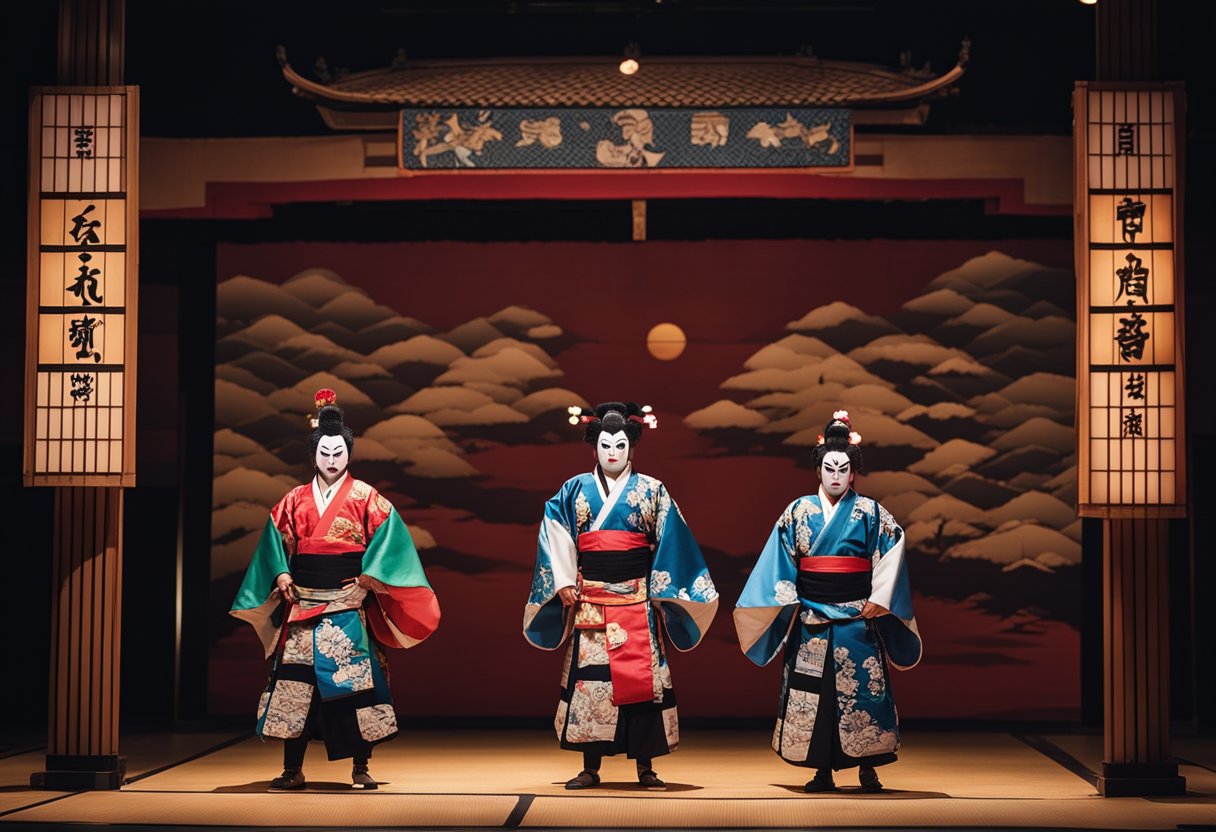
Kabuki’s Adaptability Through Time
Kabuki began in the Edo period when Japan was under the shogun’s rule. Over the centuries, it has demonstrated an impressive ability to adapt to evolving tastes while maintaining its core traditions. Initially performed by women and later by men assuming both male and female roles, Kabuki has remained a popular form of entertainment by incorporating themes and stories that resonate with its audience, whether from Japan’s feudal past or its modern society.
During the Meiji era, as Japan opened up to Western influences, Kabuki absorbed elements from European theatre. Yet, the emphasis on traditional styles and conventions, such as the unique mie poses and the onnagata (male actors portraying female roles), has persisted. By adhering to its roots while keeping an eye on contemporary relevance, Kabuki has survived through social and political upheaval.
Innovation Within the Conventional Framework
Within the conventional framework of Kabuki, creative flourishes thrive, as seen in the elaborate set designs and intricacies of costume, showcasing a blend of historical accuracy and artistic license. Innovations also surface in the use of music and staging techniques. Kyōgen, the comic interludes traditionally performed between acts of a Noh play, have influenced Kabuki, contributing to its dynamic nature.
Even as modern technology offers new possibilities for stagecraft, the essence of Kabuki remains grounded in its historical narrative and distinctive aesthetic. The performing art continues to capture the essence of Japanese tradition while delivering it through contemporary spectacles, ensuring its place in both the history and modern landscape of Japanese arts.
Prominent Figures and Innovators of Kabuki
Kabuki theatre has been shaped significantly by notable individuals, both female and male, who contributed to its legacy and innovation.
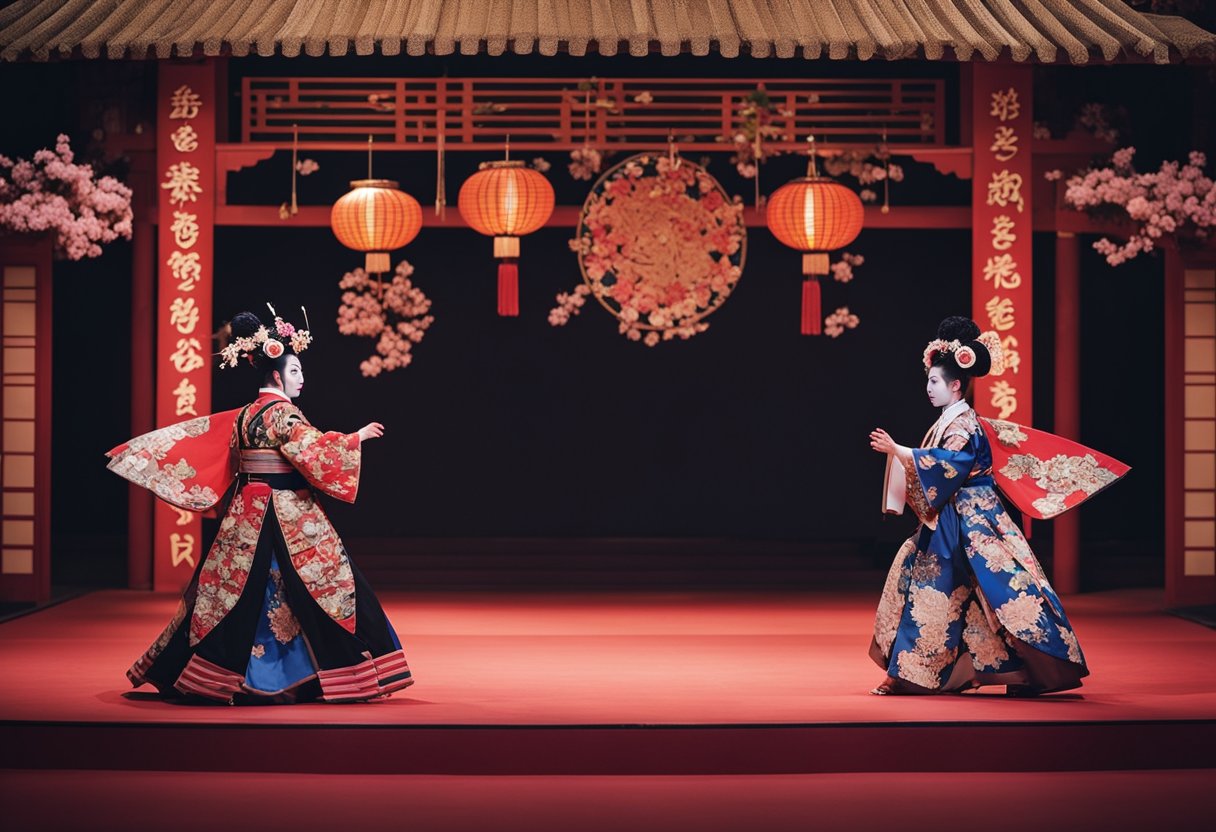
The Role of Women
Initially, the Kabuki art form was created by Izumo no Okuni, a woman who was a former courtesan and a shrine maiden from the Grand Shrine of Izumo. Her performances, which included dance and drama, were parodic interpretations of Buddhist prayers and social roles. However, women were soon barred from performing, leading to the rise of male actors known as onnagata, who specialised in female roles. These male actors mastered the skill and artistry necessary to portray women convincingly on stage.
Male Actors and Their Legacy
Without women, these onnagata male actors preserved the female influence in Kabuki theatre and became central to the tradition. Over the years, numerous male actors have left an indelible mark on Kabuki theatre. Their legacy is seen in the performance skills they passed down and the elaborate costume designs that evolved with the influence of these dedicated artisans. These actors embodied the art form and helped in the evolution of Kabuki from its humble beginnings to the highly stylised and dramatic spectacle it is recognised for today.
Plot Types and Themes in Kabuki Repertoire
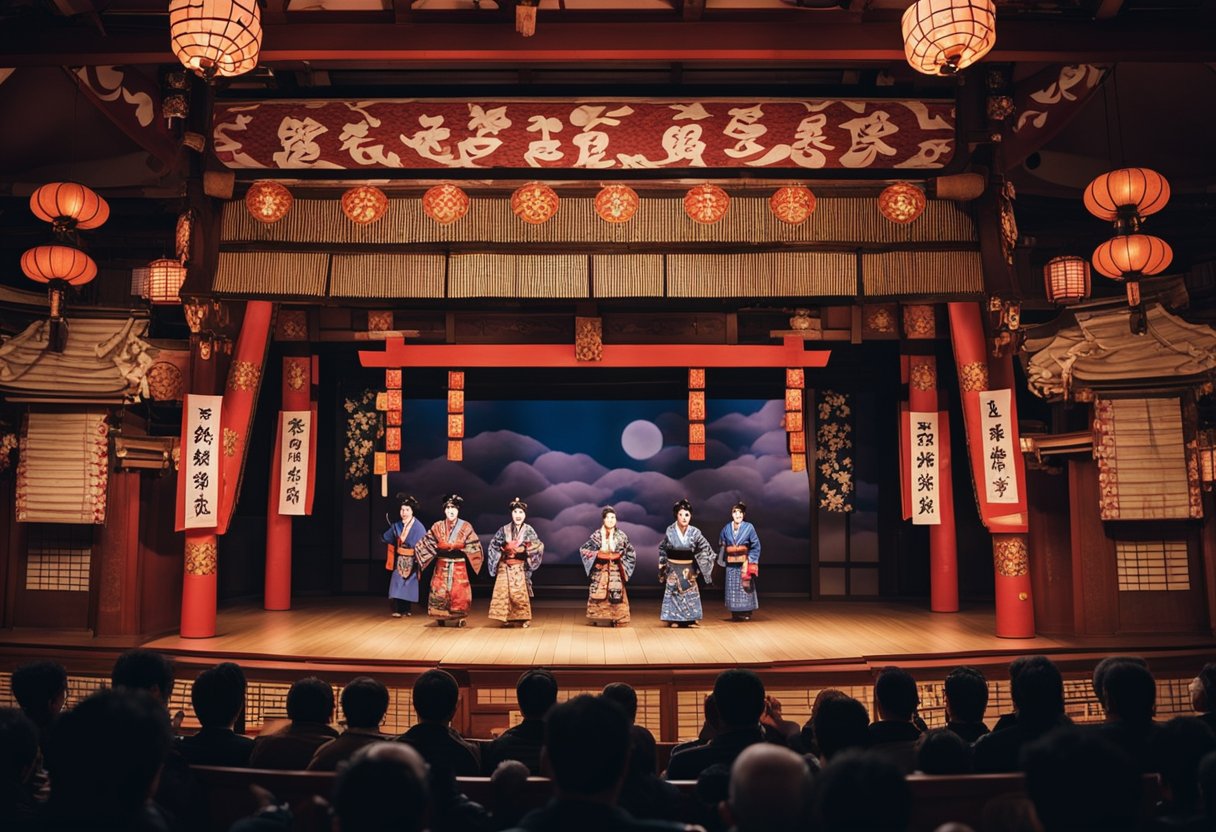
Kabuki theatre is a visual spectacle rich in tradition, presenting a diverse array of plot types and themes that have captivated audiences for centuries. Its repertoire stems from historical dramas, domestic stories, and dance pieces.
Jidaimono, or historical dramas, depict events from Japan’s illustrious past, often focusing on samurai culture, loyalty, and honour. The grand tale of the Chūshingura centred on the loyal rōnin avenging their master’s death is a paramount example of this genre.
In contrast, sewamono portrays the intricate lives of common people, delving into the complexities of societal relationships and moral dilemmas. These domestic dramas carefully mirror Edo period society and stand out for their relatability and emotional depth.
Shosagoto, dance dramas, introduce audiences to stylised movement accompanied by music, where dance becomes the storytelling medium.
Sugawara Denju Tenarai Kagami is a unique drama that masterfully integrates both jidaimono and sewamono elements, weaving a narrative around historical characters and their moving, dramatic experiences.
| Key Themes in Kabuki | Description |
|---|---|
| Loyalty & Vengeance | Recurring in historical epics like Chūshingura. |
| Tragedy & Conflict | Central to dramas reflecting human struggles. |
| Heroism & Sacrifice | Echoed in the portrayals of samurai and their ideals. |
| Love & Morality | Explored in domestic sewamono plots. |
Our showcase of characters spans the virtuous and the vile, each embodying the depth of human emotions. The theatrical artistry lies not only in the grandeur of costumes and the dynamism of the stage but also in the profound narratives drawn from literature and history, commanding respect and admiration for this unique art form.
The Future of Kabuki Theatre
As enthusiasts of traditional Japanese performing arts, we recognise that Kabuki theatre faces the challenge of remaining relevant in a modern world teeming with myriad forms of entertainment. For Kabuki to continue thriving, innovation is key—blending its rich heritage with contemporary elements that appeal to today’s audience.
We are witnessing a subtle infusion of modern themes into traditional narratives, attracting longstanding patrons and newer spectators alike. This adaptation is necessary to maintain the art form’s vibrancy and appeal while ensuring longevity. Preserving the heart of Kabuki, with its grandiose spectacles and elaborate costumes, while allowing fresh content to emerge, forms a bridge between the past and future.
Expectations for the future include enhancing the overall experience for theatregoers through technological advancements. Incorporating modern lighting and sound techniques can enrich the sensory experience without detracting from Kabuki’s authentic style. Above all, the essence and aesthetic of Kabuki must remain intact; its stylised movements, the unique cadence of lines delivered by actors, and the traditional music create an immersive spectacle that is fundamentally Kabuki.
In addition, efforts to attract a younger demographic involve education and outreach. Workshops, interactive programmes, and social media campaigns are making headway in this regard, generating a newfound interest in Jong. As we look forward, we recognise the importance of nurturing the next generation of performers and audiences. Our role is to support these venerable traditions while evolving with the times.
The future of Kabuki is undoubtedly poised for evolution. We believe it will continue to be a treasured art form that recalls a glorious past and embraces the future with open arms. The tradition, drama, and spectacle of Kabuki will undoubtedly endure, renewing its spirit for generations to come.
Frequently Asked Questions
We’ve gathered some of the most commonly asked questions about the Kabuki Theatre to provide clarity and insight into this quintessential Japanese art form.
What are the distinctive features of Kabuki Theatre?
Kabuki Theatre is renowned for its elaborate makeup, called kumadori, and its extravagant costumes. The performances are marked by stylised movements and the use of mie, a technique where actors hold a picturesque pose to highlight significant moments in the performance.
How do performances in Kabuki Theatre typically unfold?
Performances in Kabuki Theatre involve a combination of acting, singing, and dancing. The plot usually unfolds through a mix of spoken dialogue and musical segments, with the dramatic storyline often emphasised through atmospheric music played by live musicians.
Can you name some classic characters seen in Kabuki performances?
Classic characters in Kabuki include the onnagata, male actors who specialise in female roles, and the aragoto, a bombastic and exaggerated style of male characters, often portrayed with bold, red makeup.
What are the fundamental differences between Kabuki and other forms of traditional Japanese drama?
Kabuki is distinct from Noh Theatre, which is more subdued and minimalist, and Bunraku, which is a traditional Japanese puppet theatre. Kabuki is more dynamic, emphasising action, elaborate stagecraft, and the interaction between performers and the audience.
In what ways does Kabuki Theatre embody Japanese cultural traditions?
Kabuki Theatre embodies Japanese cultural traditions by reflecting historical narratives, moral dilemmas, and societal norms. It often incorporates classical Japanese dances, folklore, and themes of loyalty, love, and vengeance that resonate deeply with Japanese values and aesthetics.
How does Kabuki Theatre integrate political messages within its performances?
Kabuki Theatre has historically integrated political messages through allegory and metaphor, skilfully weaving commentary on contemporary issues into its tales of the past. This allows the art form to remain relevant and thought-provoking while adhering to the expectations of its traditional structure.



